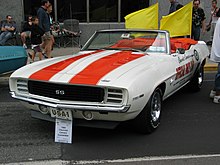 |
| My friends Z pictured her is far from stock but still has all the classic looks |
1969
The general appearance of the 1969 Camaro did not change much compared to the first two years, having kept the basic body lines and basic "look". This slight transformation was similar to the changes made to the 1968 model to make it look different than the 1967 model. The 1969 Camaro carried over the previous year's drivetrain and major mechanical components, but all-new sheetmetal, except the hood and trunk lid, gave the car a substantially sportier look. The grille was redesigned with a heavy "V" cant and deeply inset headlights. New door skins, rear quarter panels, and rear valance panel also gave the car a much lower, wider, more aggressive look. This styling would serve for the 1969 model year only. Collectors often debate the merits of smooth, rounded lines of 1967 and 1968 model versus the heavily creased and sportier looks of the 1969.
Several new performance options were available for the 1969 model year.
To increase competitiveness in the SCCA Trans Am racing series, optional four wheel disc brakes with four-piston calipers were made available during the year, under RPO JL8, for US$500.30.This system used components from the Corvette and made for a major improvement in the braking capability and was a key to winning the Trans Am championship.
The Rally Sport (RS) option, RPO Z22, Z22 Rally Sport Package; includes special black painted grille with concealed headlights and headlight washer, fender striping (except when sport striping or Z28 Special Performance Package is specified), simulated rear fender louvers, front and rear wheel opening moldings, black body sill, RS emblems on grille, steering wheel and rear panel, Rally Sport front fender nameplates, bright accented taillights, back-up lights below rear bumper; also includes bright roof drip moldings on Sport Coupe. $131.65, 37,773 built. This option could be added to any other option IE- SS or Z/28, making the model a RS/SS or the HIGHLY desirable and RARE z/28/RS.
The Z28 performance option could also be had with dealer-installed dual four-barrel crossram intake manifold (shipped in the trunk)
Also available was the F41 suspension, which had staggered shocks, multi-leaf springs in back, faster-ratio steering box, and 15 in (38 cm) by 7 in (18 cm) rims.
A GM corporate edict forbade Chevrolet from installing engines larger than 400 cu in (6.6 l). Requests from dealers (notably Yenko) who were dealer-installing 427 cu in (7.0 l) engines in the Camaro caused Chevrolet to use an ordering process usually used on fleet and special orders (taxis, trucks, etc.) to offer 427 engines in the Camaro. Two Central Office Production Orders (COPO), numbers 9560 and 9561, were offered in the 1969 model year. The COPO 9561 option brought the solid lifter L72 big-block engine, making an underrated 425 hp (317 kW) gross. Dealer Don Yenko ordered 201 of these cars to create the now-legendary Yenko Camaro. Other dealers also became aware of the L72 engine package and ordered it. Around 1,015 Camaros were fitted with the L72 engine option
The 1969 model year was exceptionally long, extending into November 1969, due to engineering problems that delayed the introduction of the second generation model planned for 1970. It is a popular myth late-'69 Camaros were sold as 1970 models (due to GM publicity pictures of the '69 Camaro labeled as a 1970), but they were all assigned 1969 VIN codes. The proposed '69 SS350, intended to address the delay, was instead sold as a '70.
Production numbers:
| RS: | 37,773 |
| SS: | 34,932 |
| Z28: | 20,302 |
| Total: | 243,085] |
Camaro ZL-1
The Central Office Production Order (COPO) 9560 was an option installed an all-aluminum 427 cu in (7 L) big-block called the ZL-1 and was designed specifically for drag racing. It was conceived by drag racer Dick Harrell, and ordered through Fred Gibb Chevrolet in La Harpe, IL, with the intention of entering NHRA Super Stock drag racing. Just 69 ZL-1 Camaros were produced, the engine alone cost over US$4,000 — nearly twice that of a base coupe with a V8. Though rated at 430 hp (321 kW) gross, the ZL-1 made 376 SAE Net HP (in its "as installed" state). http://www.camaros.org/copo.shtml
The ZL1 engines were hand assembled in a process that took 16 hours each, in a room that Corvette Chief Engineer Zora Arkus-Duntov described as "surgically clean". All ZL1 engines were manufactured at the Tonawanda Assembly Plant before being installed in Corvettes, Camaros, or sold over the counter to racers.


No comments:
Post a Comment